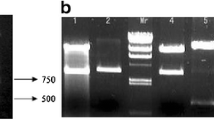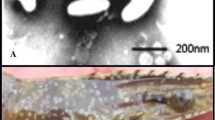Abstract
Although a white spot syndrome virus (WSSV) subunit vaccine could significantly enhance the immune response and benefit the shrimp host, its practical application is currently not feasible because of drawbacks in existing expression systems. We generated a transgenic Dunaliella salina (D. salina) strain by introducing the WSSV VP28 gene to produce a novel oral WSSV subunit vaccine. Following transformation of D. salina, VP28 gene expression was assessed by reverse transcription polymerase chain reaction (RT-PCR) assays, enzyme-linked immunosorbent assays (ELISAs), and western blot analysis. The RT-PCR results indicated that the VP28 gene was successfully expressed in D. salina cells. The presence of recombinant VP28 proteins with natural bioactivity was confirmed by western blot analysis and ELISA. Animal vaccination experiments indicated that transgenic D. salina can induce protection against WSSV by oral delivery in crayfish. Our findings indicate that the VP28 gene can be successfully expressed in transgenic D. salina and can be applied as an oral vaccine to protect crayfish against WSSV. We have demonstrated that it is feasible to produce an oral vaccine using D. salina, and thereby provide a new method for controlling other viral diseases in crustaceans.








Similar content being viewed by others
References
Namikoshi A, Wu JL, Yamashita T, Nishizawa T, Nishioka T, Arimoto M (2004) Vaccination trials with Penaeus japonicus to induce resistance to white spot syndrome virus. Aquaculture 229:25–35
Zhu F, Du HH, Miao ZG, Quan HZ, Xu ZR (2009) Protection of Procambarus clarkii against white spot syndrome virus using inactivated WSSV. Fish Shellfish Immunol 26:685–690
Witteveldt J, Cifuents CC, Vlak JM, Van Hulten MCW (2004) Protection of Penaeus monodon against white spot syndrome virus by oral vaccination. J Virol 78:2057–2061
Rajeshkumar S, Venkatesan C, Sarathi M, Sarathbabu V, Thomas J, Anver Basha K, Sahul Hameed AS (2009) Oral delivery of DNA construct using chitosan nanoparticles to protect the shrimp from white spot syndrome virus (WSSV). Fish Shellfish Immunol 26:429–437
Mejía-Ruíz CH, Vega-Peña S, Alvarez-Ruiz P, Escobedo-Bonilla CM (2011) Double-stranded RNA against white spot syndrome virus (WSSV) vp28 or vp26 reduced susceptibility of Litopenaeus vannamei to WSSV, and survivors exhibited decreased susceptibility in subsequent re-infections. J Invertebr Pathol 107:65–68
Zhu F, Zhang X (2012) Protection of shrimp against white spot syndrome virus (WSSV) with β-1, 3-d-glucan-encapsulated vp28-siRNA particles. Mar Biotechnol (NY) 14:63–68
Tsai JM, Wang HC, Leu JH, Hsiao HH, Wang AH, Kou GH, Lo CF (2004) Genomic and proteomic analysis of thirty-nine structural proteins of shrimp white spot syndrome virus. J Virol 78:11360–11370
Tsai JM, Wang HC, Leu JH, Wang AH, Zhung Y, Walker PJ, Kou GH, Lo CF (2006) Identification of the nucleocapsid, tegument, and envelope proteins of the shrimp white spot syndrome virus virion. J Virol 80:3021–3029
Van Hulten MCW, Witteveldt J, Snippe M, Vlak JM (2001) White spot syndrome virus envelope protein VP28 is involved in the systemic infection of shrimp. Virology 285:228–233
Yi GH, Wang ZM, Qi YP, Yao LG, Qian J, Hu LB (2004) Vp28 of shrimp white spot syndrome virus is involved in the attachment and penetration into shrimp cells. J Biochem Mol Biol 37:726–734
Jha RK, Xu ZR, Bai SJ, Sun JY, Li WF, Shen J (2007) Protection of Procambarus clarkii against white spot syndrome virus using recombinant oral vaccine expressed in Pichia pastoris. Fish Shellfish Immunol 22:295–307
Caipang CM, Verjan N, Ooi EL, Kondo H, Hirono I, Aoki T, Kiyono H, Yuki Y (2008) Enhanced survival of shrimp, Penaeus (Marsupenaeus) japonicus from white spot syndrome disease after oral administration of recombinant VP28 expressed in Brevibacillus brevis. Fish Shellfish Immunol 25:315–320
Tang X, Hew CL (2007) Expression, purification and crystallization of two major envelope proteins from white spot syndrome virus. Acta Crystallogr Sect F Struct Biol Cryst Commun 63:624–626
Hou CL, Cao Y, Xie RH, Wang YZ, Du HH (2011) Characterization and diagnostic use of a monoclonal antibody for VP28 envelope protein of white spot syndrome virus. Virol Sin 26:260–266
Syed SM, Kwang J (2011) Oral vaccination of baculovirus-expressed VP28 displays enhanced protection against white spot syndrome virus in Penaeus monodon. PLoS One 6(11):e26428
Wei KQ, Yang JX (2011) Histological alterations and immune response in the crayfish Procambarus clarkii given rVP28-incorporated diets. Fish Shellfish Immunol 31:1122–1128
Fu LL, Shuai JB, Xu ZR, Li JR, Li WF (2010) Immune responses of Fenneropenaeus chinensis against white spot syndrome virus after oral delivery of VP28 using Bacillus subtilis as vehicles. Fish Shellfish Immunol 28:49–55
Ning D, Leng X, Li Q, Xu W (2011) Surface-displayed VP28 on Bacillus subtilis spores induce protection against white spot syndrome virus in crayfish by oral administration. J Appl Microbiol 111:1327–1336
Xue LX, Pan WD, Jiang GZ, Wang JR (2006) Patent No: US 7081567 B2: transgenic Dunuliella salina as a bioreactor
Walker TL, Purton S, Becker DK, Collet C (2005) Mocroalgae as bioreactors. Plant Cell Rep 24:629–641
Wang HH, Yin WB, Hu ZM (2009) Advances in chloroplast engineering. J Genet Genomics 36:387–398
Barzegari A, Hejazi MA, Hosseinzadeh N, Eslami S, Mehdizadeh Aghdam E, Hejazi MS (2010) Dunaliella as an attractive candidate for molecular farming. Mol Biol Rep 37:3427–3430
Hosseini Tafreshi A, Shariati M (2009) Dunaliella biotechnology: methods and applications. J Appl Microbiol 107:14–35
Feng SY, Xue LX, Liu HT, Lu PJ (2009) Improvement of efficiency of genetic transformation for Dunaliella salina by glass beads method. Mol Biol Rep 36:1433–1439
Du HH, Fu LL, Xu YX, Kil ZS, Xu ZR (2007) Improvement in a simple method for isolating white spot syndrome virus (WSSV) from the crayfish Procambarus clarkii. Aquaculture 262:532–534
Bradford MM (1976) Rapid and sensitive method for quantitation of microgram quantities of protein utilizing principle of protein-dye binding. Anal Biochem 72:248–254
Yoganandhan K, Syed SM, Narayanan RB, Sahul Hameed AS (2004) Production of polyclonal antiserum against recombinant VP28 protein and its application for the detection of white spot syndrome virus in crustaceans. J Fish Dis 27:517–522
Rosales-Mendoza S, Paz-Maldonado LM, Soria-Guerra RE (2012) Chlamydomonas reinhardtii as a viable platform for the production of recombinant proteins: current status and perspectives. Plant Cell Rep 31:479–494
Surzycki R, Greenham K, Kitayama K, Dibal F, Wagner R, Rochaix JD, Ajam T, Surzycki S (2009) Factors effecting expression of vaccines in microalgae. Biologicals 37:133–138
Doran PM (2006) Foreign protein degradation and instability in plants and plant tissue cultures. Trends Biotechnol 24:426–432
Muto M, Henry RE, Mayfield SP (2009) Accumulation and processing of a recombinant protein designed as a cleavable fusion to the endogenous Rubisco LSU protein in Chlamydomonas chloroplast. BMC Biotechnol 9:1–11
Acknowledgements
This work was supported by the National Natural Science Foundation of China (No. 30900796) and the Doctor’s Research Initial Fund of Henan University of Science and Technology (No. 09001413). Special thanks are owed to David Michael Grobe from Indiana University-Purdue University Indianapolis for his proofreading of the manuscript.
Author information
Authors and Affiliations
Corresponding author
Rights and permissions
About this article
Cite this article
Feng, S., Feng, W., Zhao, L. et al. Preparation of transgenic Dunaliella salina for immunization against white spot syndrome virus in crayfish. Arch Virol 159, 519–525 (2014). https://doi.org/10.1007/s00705-013-1856-7
Received:
Accepted:
Published:
Issue Date:
DOI: https://doi.org/10.1007/s00705-013-1856-7




